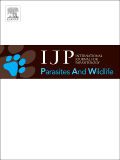
International Journal for Parasitology-Parasites and Wildlife
Scope & Guideline
Connecting Research and Conservation in Parasitology
Introduction
Aims and Scopes
- Ecological and Evolutionary Dynamics of Parasitism:
Research in this area investigates the interactions between parasites and their wildlife hosts, focusing on how these relationships influence ecological dynamics and evolutionary processes. - Molecular Characterization and Phylogenetics:
The journal publishes studies utilizing advanced molecular techniques for the identification and characterization of parasites, contributing to the understanding of their phylogenetic relationships and evolutionary history. - Epidemiology and Public Health Implications:
Papers often address the epidemiological aspects of parasitic infections in wildlife, exploring their impact on public health, wildlife conservation, and disease transmission between wildlife and domestic animals. - Diversity and Taxonomy of Parasites:
The journal provides a platform for taxonomic studies that describe new species and assess the diversity of parasitic organisms across various wildlife species and habitats. - Conservation and Management Strategies:
Research that discusses the implications of parasitism on wildlife conservation and management practices is a key focus, with an emphasis on developing strategies to mitigate negative impacts on wildlife populations.
Trending and Emerging
- Environmental and Climate Change Effects:
Recent publications increasingly explore how environmental factors and climate change influence parasite dynamics, host susceptibility, and disease transmission, reflecting a growing recognition of the importance of these issues in parasitology. - Zoonotic Diseases and One Health Approach:
There is a marked increase in research focusing on zoonotic parasites and their implications for public health, aligning with the One Health framework that emphasizes the interconnectedness of human, animal, and environmental health. - Genomic and Metagenomic Approaches:
The use of genomic and metagenomic techniques is on the rise, allowing for comprehensive assessments of parasitic diversity and community structure, as well as insights into host-parasite interactions at a molecular level. - Parasite-Driven Behavioral Manipulation:
Emerging studies are investigating the effects of parasites on host behavior, particularly in wildlife, which has implications for understanding host-parasite co-evolution and ecological dynamics. - Conservation Parasitology:
A growing body of work is dedicated to understanding the role of parasites in wildlife conservation, including how parasites can affect endangered species and the strategies needed to manage these interactions effectively.
Declining or Waning
- Traditional Parasitology Techniques:
There has been a noticeable decline in studies relying solely on traditional parasitological methods, such as morphological identification, as researchers increasingly adopt molecular techniques that offer more precise identification and characterization. - Host-Specific Parasite Interactions:
Research specifically focused on host-specific interactions is becoming less common, possibly overshadowed by broader ecological and evolutionary studies that consider multi-host systems and their implications. - Case Studies of Individual Species:
There appears to be a waning interest in case studies that focus on individual parasite species or host species in isolation, with a trend towards more integrative studies that consider community dynamics and broader ecological contexts.
Similar Journals

Revista Agrogeoambiental
Advancing Sustainability Through Interdisciplinary ResearchRevista Agrogeoambiental is a prestigious open-access academic journal dedicated to the field of agricultural and environmental sciences. Published by INST FEDERAL SUL MINAS GERAIS-I FSULDEMINAS since 2009, this journal stands as a vital forum for the dissemination of research findings, innovative methodologies, and interdisciplinary studies that address critical issues in agriculture and environmental sustainability. With a focus on promoting knowledge exchange among researchers, practitioners, and educators, Revista Agrogeoambiental seeks to enhance understanding of agroecological systems and their interaction with geospatial frameworks. As an open-access journal, it ensures that cutting-edge research is accessible to a wide audience, thereby fostering collaboration and knowledge-sharing in the global academic community. Researchers and professionals can benefit from the journal's commitment to high standards of scholarship, as well as its role in shaping policy and practice within the agricultural and environmental sectors.

CALIFORNIA FISH AND GAME
Advancing Conservation Through ResearchCalifornia Fish and Game is a prominent journal dedicated to the fields of Animal Science and Aquatic Science, published by the California Fish and Game Editor. With its roots extending back to 1979, the journal has served as a vital platform for disseminating research focused on the wildlife and aquatic ecosystems of California and beyond. Recognized within the Q4 quartile for both Animal Science and Zoology and Aquatic Science, it provides critical insights and scholarly contributions, despite its comparative rankings within the respective categories. The journal, with an ISSN of 0008-1078 and an E-ISSN of 2331-0405, offers an invaluable resource for researchers, professionals, and students alike, looking to deepen their understanding of California's rich biodiversity and ecological challenges. For those interested in open access options, further details can be reviewed through the journal's platform. By fostering a community of inquiry, California Fish and Game plays an essential role in advancing knowledge and conservation efforts in the fields of interest.

SYSTEMATIC PARASITOLOGY
Pioneering insights into the world of parasites.SYSTEMATIC PARASITOLOGY, a premier academic journal published by Springer, serves as a vital resource in the field of parasitology. Since its inception in 1979, this journal has committed itself to advancing the understanding of parasitic organisms and their interactions with hosts, thus playing a significant role in both basic and applied research. With an impactful contribution to the scientific community—evidenced by its Scopus ranking and its position in the third quartile (Q3) within the Parasitology category—the journal provides a platform for high-quality, peer-reviewed research that spans a variety of topics from molecular biology to ecology. Although not currently open access, SYSTEMATIC PARASITOLOGY remains essential for researchers, professionals, and students who seek to stay at the forefront of parasitological studies and contribute to ongoing developments in the domain. Published in the Netherlands, it continues to attract a diverse international readership, fostering a collaborative scientific environment.

FOLIA PARASITOLOGICA
Navigating the Frontiers of Parasitic Biology.FOLIA PARASITOLOGICA is a distinguished scholarly journal published in the Czech Republic, focusing on the field of parasitology. With a commitment to advancing knowledge in parasitology, the journal covers a wide array of topics including the biology and control of parasites, host-parasite interactions, and epidemiology. Having been in circulation since 1971 and currently converging its years of research until 2024, FOLIA PARASITOLOGICA has established itself as a vital resource for researchers, professionals, and students in immunology and microbiology, currently ranked in the Q3 category for Parasitology. Although it does not operate under an open-access model, the journal's relevance is underscored by its Scopus ranking, where it is positioned 47th out of 79 in the field, reflecting the high standards of research it publishes. By hosting a range of studies and reviews, FOLIA PARASITOLOGICA continues to contribute significantly to the scientific community, fostering advancements that enhance our understanding and management of parasitic diseases.

KOREAN JOURNAL OF PARASITOLOGY
Innovating Solutions for Parasitic DiseasesKorean Journal of Parasitology is a respected publication in the field of parasitology, originating from the esteemed Korean Society of Parasitology and affiliated with Seoul National University College of Medicine. Established in 1977, this journal focuses on disseminating significant research findings related to parasitic diseases, their vectors, and control measures, serving as a vital resource for researchers, medical professionals, and students alike. Although coverage in Scopus has been discontinued as of 2022, the journal remains a valuable platform for in-depth studies within the areas of Infectious Diseases and Immunology. With an ISSN of 0023-4001 and an E-ISSN of 1738-0006, the journal promotes open access to enhance academic sharing. Despite its current Scopus rankings, which place it in the 38th percentile for Infectious Diseases and 37th percentile for Immunology and Microbiology (Parasitology), it continues to contribute to the global discourse on parasitological research, encouraging collaboration and emphasizing the importance of this field in public health.
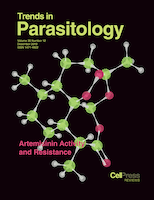
TRENDS IN PARASITOLOGY
Exploring the dynamics of infectious diseases.TRENDS IN PARASITOLOGY is a premier academic journal published by CELL PRESS, focusing on the dynamic field of parasitology and infectious diseases. With an ISSN of 1471-4922, this esteemed journal is recognized for its high impact within the research community, boasting a Q1 ranking in both the Infectious Diseases and Parasitology categories as of 2023. This places it among the top-tier journals in the field, as evidenced by its remarkable Scopus rankings, where it ranks #3 out of 79 in Parasitology and #29 out of 344 in Infectious Diseases. Spanning over two decades of scholarly contributions from 2001 to 2024, TRENDS IN PARASITOLOGY emphasizes the latest advancements, challenges, and innovative methodologies in parasitology, making it an invaluable resource for researchers, healthcare professionals, and students alike. With an increasing focus on open access initiatives, this journal not only promotes widespread dissemination of knowledge but also encourages collaboration across the global scientific community. Whether you are investigating novel interventions, exploring parasite evolution, or understanding host-pathogen interactions, TRENDS IN PARASITOLOGY remains at the forefront of research, driving forward the understanding of parasitic diseases.

REVISTA BRASILEIRA DE PARASITOLOGIA VETERINARIA
Bridging Local Insights with Global Parasitology TrendsThe REVISTA BRASILEIRA DE PARASITOLOGIA VETERINARIA, published by the BRAZILIAN COLLEGE OF VETERINARY PARASITOLOGY, serves as a premier platform for disseminating groundbreaking research and advancements in the field of veterinary parasitology. Since its transition to Open Access in 2007, the journal has significantly contributed to fostering global collaboration and knowledge sharing among researchers and practitioners. Situated in Brazil, this esteemed journal features a diverse range of studies focused on the latest developments and challenges in veterinary and parasitological sciences. With a commendable Q3 ranking in Parasitology and Q2 ranking in Veterinary (miscellaneous) for 2023, it is recognized for its growing impact in the academic community, particularly holding positions in the 60th percentile for General Veterinary and 37th percentile in Parasitology. Researchers, professionals, and students interested in enriching their understanding of veterinary parasitology will find this journal a vital resource, as it bridges regional expertise with global research trends, thus embracing a holistic approach to veterinary health.
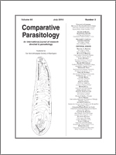
Comparative Parasitology
Bridging Ecology and Evolution in Parasitic StudiesComparative Parasitology, published by the Helminthological Society of Washington, serves as a vital platform for the dissemination of innovative research in the fields of parasitology, ecology, and evolution. With an ISSN of 1525-2647 and an E-ISSN of 1938-2952, this journal has charted a course of academic influence since its inception in 1996, and is set to continue until 2024. Although it currently holds a Q4 ranking in both Ecology, Evolution, Behavior and Systematics and Parasitology categories, it guarantees significant contributions and diverse studies, providing an essential resource for researchers and practitioners in these domains. Located in the United States and managed by Allen Press Inc, Comparative Parasitology emphasizes open access, ensuring that vital research findings are readily available to the global community. The journal remains dedicated to fostering an understanding of the complexities of host-parasite interactions and promoting interdisciplinary collaboration, making it a crucial resource for students and professionals alike.
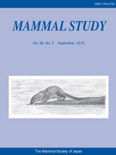
MAMMAL STUDY
Unveiling the secrets of mammalian life through rigorous research.Mammal Study, published by the Mammalogical Society of Japan, is a leading academic journal dedicated to the field of mammalogy and related biological sciences. Since its inception, it has provided a critical platform for researchers, professionals, and students to share their findings and insights into the diverse facets of mammalian biology, ecology, and conservation. The journal, with ISSN 1343-4152 and E-ISSN 1348-6160, is recognized for its rigorous peer-review process and has attained a commendable Q3 ranking in the 2023 category of Animal Science and Zoology. With an impact factor reflecting its growing influence—ranking 283 out of 490 in Scopus—we welcome contributions that advance the understanding of mammalian species and their habitats. While access to published articles is through traditional channels, the journal aims to reach an even wider audience by fostering greater awareness and appreciation for mammalian research and conservation efforts. The Mammal Study has converged years of insightful publications from 2008 to 2024, solidifying its position as a vital resource in the biological sciences.
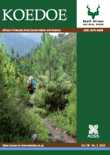
KOEDOE
Exploring the intricacies of our environment since 1958.KOEDOE, an esteemed journal in the field of ecology and environmental science, has been a vital platform for scholarly discourse since its inception in 1958. Published by AOSIS in South Africa, this open-access journal facilitates the dissemination of high-quality research and insights, contributing to advancements in ecological understanding and practice. With an impressive Q2 ranking in Ecology and Q3 ranking in Ecology, Evolution, Behavior, and Systematics as of 2023, it serves as a crucial resource for researchers, professionals, and students alike. The journal’s commitment to open access ensures that the latest findings are readily available to a global audience, fostering an inclusive academic community. KOEDOE's inception periods span significant years, marking its evolution alongside the ecological challenges of our time. Its Scopus ranking underscores its impact and relevance in the fields of agricultural and biological sciences, making it an essential read for those seeking to deepen their understanding of ecological dynamics.